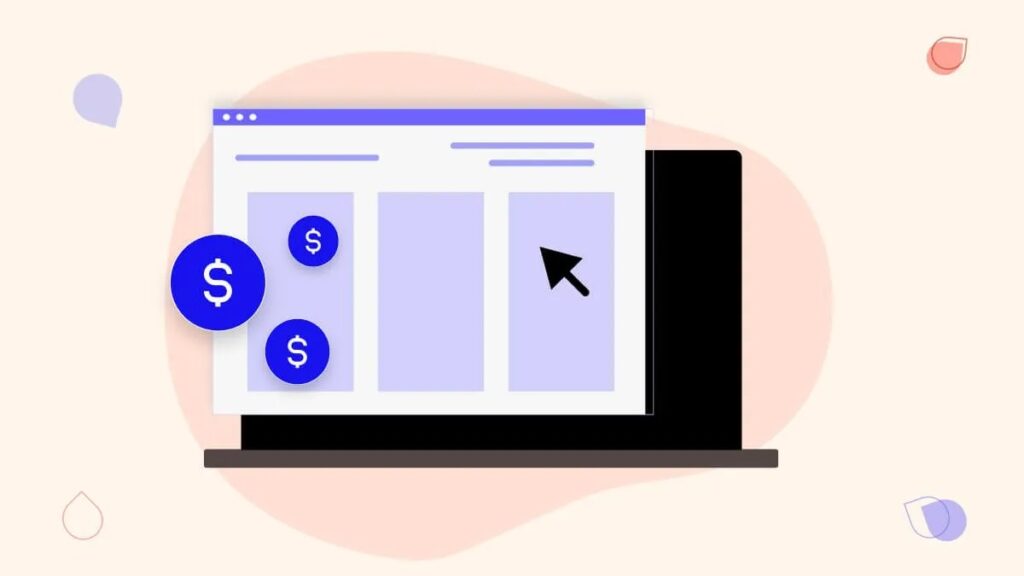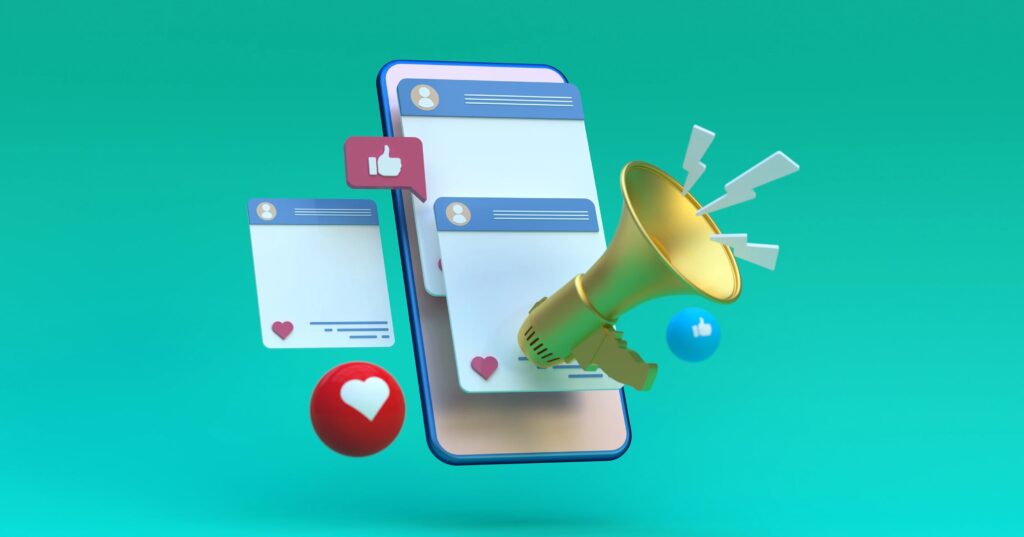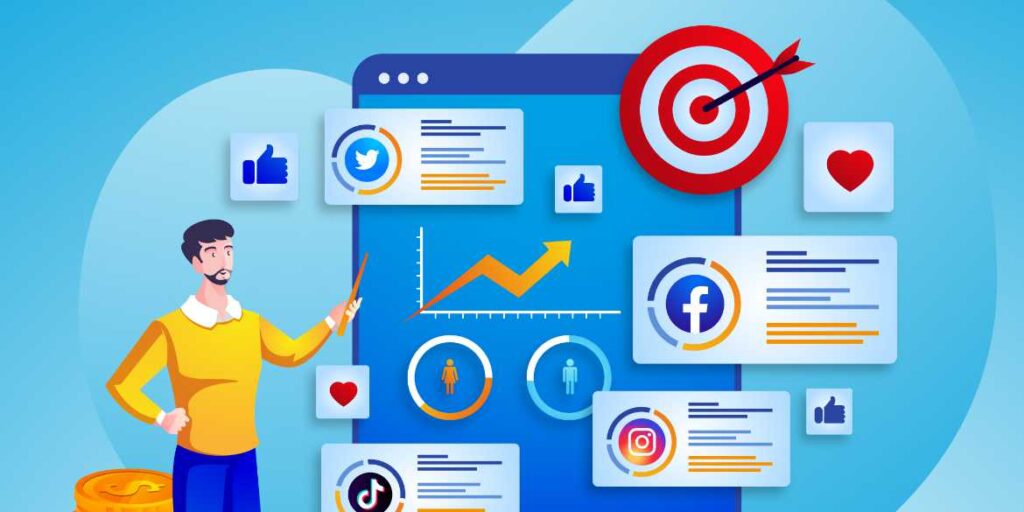Are you doing everything you can to optimize your Facebook ads costs? Discover the best ways to increase your ROI with audience targeting, bidding, and more.
In 2018, Mark Zuckerberg stood before the US Congress in the wake of the Cambridge Analytica scandal, which many called the downfall of Facebook: . Much has changed since then, but that moment marked the beginning of a new era in social media advertising.
Years later, Facebook is still around, and advertising costs on the platform are skyrocketing.
In 2021 alone, Facebook recorded more than $114 billion in advertising revenue, showing a growing interest in advertising (only a year ago it was $84 billion).
Despite all the scandals, Facebook ads remain one of the most profitable platforms if you want to monetize your digital marketing funnel.
How much does it really cost to advertise on Facebook? How can you keep costs down in 2024? Check out this now…


How does the Facebook ad auction work?
Facebook Ads is a pay-per-click (PPC) advertising platform. The ads you see on Facebook are the result of a bidding process called an “ad auction.” This bidding process occurs when someone bids on a specific audience.
In this ad auction, advertisers compete to have their ads displayed by placing bids based on how much they spend on campaigns and customer acquisition.
The bid amount is then weighed against other factors such as the audience the ad is targeting and the quality of the ad itself. The higher an advertiser bids, the more likely their ad will appear in the targeted Her group in the News Her feed or sidebar.
Advertisers can also lower their cost-per-click (CPC) if their ads are high quality and relevant. This is because Facebook rewards advertisers who create ads that provide a good user experience.
Facebook Ads also offers campaign optimization options, including: B. Automated Bidding – Bid amounts are automatically increased or decreased to focus on high-performing ad groups, achieve better results, and maximize campaign performance.
This type of Facebook automation allows advertisers to get the most out of their campaigns and reach their desired audience. Understanding how Facebook advertising works allows advertisers to create effective advertising campaigns and maximize their impact on their target customers.
With a powerful auction system, this platform offers a great way to reach potential customers and increase conversions.
Are you looking to improve your advertising costs? Structure your advertising campaigns correctly.
How much do Facebook Ads cost?
Facebook charges advertisers based on a variety of metrics. The most common are cost per click (CPC), cost per thousand (CPM), and cost per lead (CPL).
CPC is the cost per click your ad receives, CPM is the cost per 1,000 impressions your ad receives, and CPL is the cost of each lead generated by your Facebook ad.
In general, campaigns with larger advertising budgets tend to be more effective because they have access to a wider range of features and options to optimize the campaign and attract more attention.
Average CPC for Facebook Ads
Facebook’s average CPC is around $1. Of course, many factors influence this number. However, in total, he should expect to pay around $0.94 per click, or $12.07 to $14 for every 1,000 impressions he receives on his Facebook ads.
This can be translated into business terms as follows. If you sell a product that costs $50 and your conversion rate is 2.5-3% (like e-commerce average), you need to generate 33 – 40 clicks to get the sale.
If your average CPC is $1, you’ll need a budget of at least $33. So the remaining $17 is your profit.
However, if your product costs less than $33, you may need to adjust your advertising strategy to lower your CPC to less than $1.
This can be done through a combination of tactics such as retargeting and A/B testing (more on this later).
Average CPM for Facebook Ads
If you want to pay based on the number of impressions, know that the average CPM for Facebook ads is around $14. Like CPC, CPM also responds to many factors (more on this below).
This means that if you are running a branded campaign and your average CPM is $14 and you want to reach 500,000 people, you need a budget of $7,000.
Average cost per lead
According to Revealbot, the average cost per lead (CPL) for Facebook ads is around $5. However, keep in mind that not all leads convert. Therefore, you need to consider the average conversion rate (after a potential buyer is officially marked as a lead).
The type of leads you generate affects your cost per lead. For example, requesting a free trial or demo costs more than subscribing to a newsletter. Industry and available targeting options will also affect his CPL.
What determines your Facebook ads costs?
The Facebook Ads Costs depends on a lot of factors. Some of the most important ones include:


Ad budget
Facebook allows you to set a fixed ad budget, which will determine whether you reach more people or not. The more money you spend, the larger your potential audience is going to be. However, when you are just starting out, you might want to test a small budget (and then scale accordingly).
Ad bid
Your bidding strategy will also influence how much your Facebook Ads cost. There are three main bidding strategies in Facebook Ads:
- Goal-based (pay per-result goal or pay by ROAS)
- Spend-based (based on the highest volume or the highest value)
- Manual (where you put a manual cap on each bid, rather than allow Facebook to automatically cap your bids which is called automatic bidding.)
Goal-based and spend-based bidding are automated by Facebook’s system, whereas a manual bid strategy is something you can do yourself.
To make sure you choose the right type of ad bid, you should first make sure you have a solid marketing strategy and understand how the Facebook Ads algorithm works. Essentially, the system will rate each bidder and ad according to three main criteria:
- Bid: how much do you want to pay for each user interaction with your ads
- Estimated auction rates: how likely it is that users will interact with your ads
- Ad quality and relevance: how closely your ad aligns with user interests, how well it resonates with them, and what is the perceived quality of the ad
If your ad comes out with a high score from this three-tiered assessment, you win the bid. Theoretically, an aggressive bid strategy will help you win – but it might also drive your cost per conversion up.
Ideally, you want to strike the right balance between all these key factors and find the sweet spot. And that’s where you should use the expertise of a Facebook Ads expert to help you optimize your bids.
Ad objective
The cost of your Facebook Ads will depend on the marketing objective you’ve set for your campaign: brand awareness, reach, traffic, app installs, link clicks, video views, etc.
If you choose the wrong ad objective, you might end up spending more because the automated bidding process will match your goals.
Audience
When you bid on advertising, you’re competing not only with companies in your industry, but also with companies in other industries that target the same audience.
Therefore, targeting a user that many other users are targeting will increase your advertising costs. Who your target audience is and the size of your target audience will influence your ad spend.
Leverage Custom Audiences in Every Part of Your Marketing Funnel to Continuously Feed Your Business Data.
Ad quality
Every Facebook ad with more than 500 impressions receives a relevance score, which is an indicator of how your audience reacts to your ad. The higher the relevance score, the more affordable your ads will be.
To make sure your ads have a high relevance score, you need to create content that resonates with your audience, use the right images, and include a clear call to action.
Ad placement
If your ad placement is competitive, you will pay more for your ad. Think of it like real estate: A home in a very nice area is more expensive than a home in a less popular area.
Similarly, advertising in high-visibility areas on Facebook (such as the News Feed) will cost more than advertising in areas with lower visibility. Facebook allows you to place various ads on Instagram, Audience Network, etc. to maximize your reach and attract more customers.
Industry
Your industry also influences your campaign costs. Industries like finance, legal services, B2B, customer service, and insurance are usually more competitive than others, meaning that their CPC tends to be higher.
Season
If everyone rushes to go on beach vacations in July in a given area, the accommodation and flight prices will go up.
The same is true for ads: when a lot of people are advertising in the same industry in a specific season, the cost of the ads will skyrocket.
For instance, you might end up spending more on the same ad if you publish it around Black Friday than you would on a random day in June.
9 ways to reduce your Facebook ads costs
Facebook ads only make sense if you achieve a reasonable cost per acquisition (CPA). Otherwise, you’ll be wasting your marketing budget on unsustainable channels. 9 tips to reduce your Facebook advertising costs:
1. Choose the right campaign objective
If you choose the wrong campaign objective, you will spend more and get less. Here’s an example: if you’re advertising beauty products for women, and want to set up a bottom-of-the-funnel campaign, choosing the reach objective isn’t the best choice because it will not necessarily drive sales.
Instead, choose more targeted objectives like conversions. This way, the automated Facebook bidding system will know how to use your advertising budget to get better results.
2. Narrow down your audience
The larger your audience is, the more businesses you’re competing with. Narrowing down your audience is a great way to decrease your Cost per Click (CPC).
To do this, you need to get as detailed as possible in the Audience Insights section of the Ads Manager. For example, if you sell beauty products for women, you could target specific ads to specific groups of women (age, interests, type of skin as shown by previous browsing history, etc.). This is more efficient than, say, targeting all women in a country.
3. Lower your ad frequency score
The more your ads appear in the same format on the platform the less likely your users are going to engage with them. This is called ad fatigue and it’s the reason you should decrease your ad frequency score.
If you see a low action rate on your ads it might mean it’s time to change up your ad creatives or messaging. So refresh your ads every few days or weeks, and test out different designs and ad placements. This will also help you avoid ad fatigue and keep your CTR high.
4. A/B test ad creatives and placements
A/B testing is the key to successful marketing and advertising campaigns. Often you don’t know what’s working, but A/B testing allows you to optimize your ads by comparing different versions of them.
Try to change only one variable in your A/B test variations. Otherwise, you won’t know which variables influenced your results.
For example, you can change either the ad text, motif, or placement (Desktop vs. Desktop mobile), but not all at once.
You can also test different bids and budgets. This gives you a comprehensive overview of what works (and what doesn’t).
5. Make your ads relevant
There’s no point in running ads that aren’t relevant to your target audience. Not only will this hurt your CTR, but it will also waste a lot of money in the ad bidding process (because your relevance score will be lower). Keep your ads relevant both in terms of content and in terms of targeting.
6. Run retargeting campaigns
Retargeting campaigns are an effective way to re-engage users who have already interacted with your business in some way. This could be anything from visiting your website to liking your Facebook page to filling out an online form.
Retargeting campaigns allow you to target those people who already know and trust your business. As a result, it will get you better conversions at lower costs than what you’ll get with cold traffic.
7. Improve the post-click experience
The post-click experience is just as important as the pre-click one. If you direct people to a slow or poorly designed website or landing page, they’ll almost instantly leave, which means a lower conversion rate and more costly ads.
So you need to optimize the entire marketing funnel and make sure your user has a good experience from click to purchase, and beyond.
8. Hire a Facebook Ads agency
Running ads on Facebook can feel overwhelming. There are many elements to consider and sometimes the cost of your ads on Facebook can be discouraging. Hire an expert Facebook Ads agency to save on Facebook ads costs and make sure your campaigns are successful.
Experienced advertising pros and Instagram Ads managers know how to effectively optimize campaigns and get the most out of your budget. They also have decades of experience behind them, so they know how to test different elements to maximize results for the lowest cost possible.
9. Use lookalike audiences
Facebook lookalike audiences allow you to tap into audiences similar to those who already made a purchase from you. How this works is that Facebook takes a small group of your users (e.g., people who have already purchased your product) and then finds similar audiences that fit those same parameters.
Lookalike audiences are great for increasing reach and building brand awareness. They also help you find high-quality leads at a lower price with minimum optimization effort.
Key Takeaways
Facebook Ads is one of the highest ROI marketing channels out there. However, whether Facebook Ads is worth it or not depends on a variety of factors – including your business model, bidding strategy, average click-through rates, engagement rates, and other metrics.
Advertising isn’t a magic wand. You can’t just put money in it and expect a mind-blowing ROI overnight. While it’s generally a quicker way to acquire new customers (compared to organic channels), make sure you set the right expectations for your advertising efforts.
Facebook Ads is no exception: if you want them to get you a good ROI, you need to pursue ad optimization: to constantly tinker, adjust, and re-strategize. Need a hand? Talk to Facebook ads Specialists.

